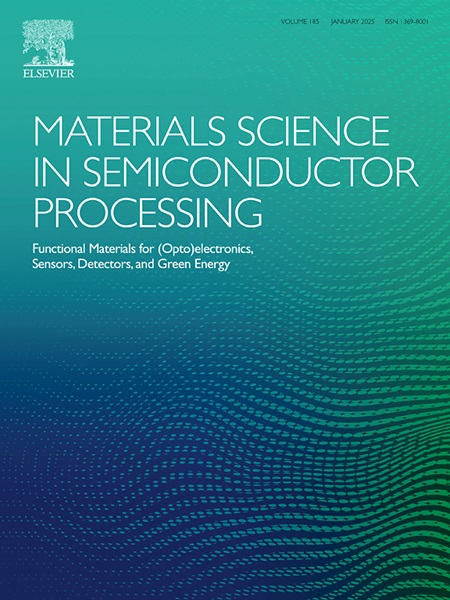Double-passivated MAPbBr3 nanocrystals with nitrogen-doped graphene quantum dots and polyvinylidene fluoride for white light LEDs
IF 4.2
3区 工程技术
Q2 ENGINEERING, ELECTRICAL & ELECTRONIC
引用次数: 0
Abstract
This study addresses the challenge of synthesizing highly emissive and stable MAPbBr3 nanocrystals (NCs) for practical device applications. A double-passivation approach was developed through using nitrogen-doped graphene quantum dots (NGQDs) and polyvinylidene fluoride (PVDF) during the in-situ synthesis of MAPbBr3 NCs. By optimizing the amount of NGQDs, the resulting MAPbBr3/PVDF/NGQDs composite films exhibited green emission at 522 nm with a narrow spectral width of 17.7 nm. The films demonstrated exceptional stability, retaining 60 % of their initial photoluminescence (PL) intensity after 144 h of water immersion and 96 % of their initial intensity after 10 min of heating at 100 °C. This stability is attributed to the NGQDs reducing defects and acting as nitrogen-enhanced sites that promote consistent crystal formation. Additionally, the composite film was used to fabricate a white light-emitting diode (WLED) with a color gamut coverage rate of 125 % under the National Television Standards Committee (NTSC) standard and 93.8 % under the Rec.2020 standard. This work might present a synergistic strategy combining in-situ defect passivation with encapsulation, offering a viable solution to the stability-efficiency trade-off in perovskite NCs and advancing high-color-gamut flexible displays.
含氮掺杂石墨烯量子点和聚偏氟乙烯的双钝化MAPbBr3纳米晶体用于白光led
本研究解决了合成高发射和稳定的MAPbBr3纳米晶体(NCs)用于实际器件应用的挑战。采用氮掺杂石墨烯量子点(NGQDs)和聚偏氟乙烯(PVDF)双钝化方法原位合成MAPbBr3纳米材料。通过优化NGQDs的用量,得到的MAPbBr3/PVDF/NGQDs复合薄膜在522 nm处具有绿色发光,光谱宽度为17.7 nm。薄膜表现出优异的稳定性,在144小时的水浸后保持了60%的初始光致发光强度,在100°C加热10分钟后保持了96%的初始光致发光强度。这种稳定性归因于NGQDs减少了缺陷,并作为氮增强位点促进了一致的晶体形成。此外,该复合薄膜还被用于制造白色发光二极管(WLED),其色域覆盖率在美国国家电视标准委员会(NTSC)标准下达到125%,在Rec.2020标准下达到93.8%。这项工作可能会提出一种将原位缺陷钝化与封装相结合的协同策略,为钙钛矿nc的稳定性和效率权衡提供可行的解决方案,并推进高色域柔性显示器。
本文章由计算机程序翻译,如有差异,请以英文原文为准。
求助全文
约1分钟内获得全文
求助全文
来源期刊

Materials Science in Semiconductor Processing
工程技术-材料科学:综合
CiteScore
8.00
自引率
4.90%
发文量
780
审稿时长
42 days
期刊介绍:
Materials Science in Semiconductor Processing provides a unique forum for the discussion of novel processing, applications and theoretical studies of functional materials and devices for (opto)electronics, sensors, detectors, biotechnology and green energy.
Each issue will aim to provide a snapshot of current insights, new achievements, breakthroughs and future trends in such diverse fields as microelectronics, energy conversion and storage, communications, biotechnology, (photo)catalysis, nano- and thin-film technology, hybrid and composite materials, chemical processing, vapor-phase deposition, device fabrication, and modelling, which are the backbone of advanced semiconductor processing and applications.
Coverage will include: advanced lithography for submicron devices; etching and related topics; ion implantation; damage evolution and related issues; plasma and thermal CVD; rapid thermal processing; advanced metallization and interconnect schemes; thin dielectric layers, oxidation; sol-gel processing; chemical bath and (electro)chemical deposition; compound semiconductor processing; new non-oxide materials and their applications; (macro)molecular and hybrid materials; molecular dynamics, ab-initio methods, Monte Carlo, etc.; new materials and processes for discrete and integrated circuits; magnetic materials and spintronics; heterostructures and quantum devices; engineering of the electrical and optical properties of semiconductors; crystal growth mechanisms; reliability, defect density, intrinsic impurities and defects.
 求助内容:
求助内容: 应助结果提醒方式:
应助结果提醒方式:


